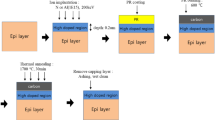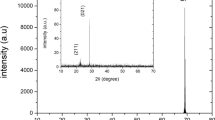Abstract
Indium metal is deposited on n-type Si (n-Si) samples with/without (NH4)2Sx treatment in order to experimentally study the mechanism for the transition from Schottky to ohmic contact. Indium metal that is deposited on a n-Si sample that is subject to (NH4)2Sx treatment shows ohmic behavior but indium metal that is deposited on a n-Si sample that is not subject to (NH4)2Sx treatment exhibits Schottky behavior. Using the transmission line method, the specific contact resistance of the In/(NH4)2Sx treated n-Si structure is calculated to be 283.3 mΩ cm2. Experimental identification confirms that the transformation to conduction behavior occurs because of the combined effect of broken Si–O bonds (i.e., the removal of the native oxide) and the formation of Si–Sx2− bonds at the Si surface, which results in a transition from upward to downward surface band bending for n-Si.





Similar content being viewed by others
References
D W Kim, J W Song, H S Jin and B Yoo Mater. Interfaces 11 25140 (2019).
Q Tang, H Shen, H Yao, K Gao, J Ge and Y Liu Appl Surf Sci 504 144588 (2020).
Ö F Yüksel, A B Selçuk and S B Ocak Physica B 403 2690 (2008).
C Bilkan and Ş Altındal J. Alloys Compd. 708 464 (2017).
E V Ostroumova and A A Rogachev Appl. Surf. Sci. 166 480 (2000).
H Aydin, C Bacaksiz, N Yagmurcukardes, C Karakaya, O Mermer, M Can and R T Senger Surf. Sci. 428 1010 (2018).
Y J Lin and C L Wu J. Phys. 94 1209 (2020).
T Y Su and M Y Chen J. Phys. 95 1356 (2021).
J F Yu and Y J Lin J. Phys. 95 865 (2021).
F Paul, K N Manjunatha, S Govindarajan and S Paul Appl. Surf. Sci. 506 144686 (2020).
A Fernández J. Phys. E: Sci. Instrum. 1 782 (1968).
B C Dobbs J. Electron. Mater. 6 705 (1977).
A Hu, W Wang and Q Xu J. Semicond. 30 084001 (2009).
D Das and L Karmakar Appl. Surf. Sci. 481 16 (2019).
J H Werner J. Appl. Phys. 75 994 (1994).
J G Zhu J. Phys. D 40 547 (2007).
M Tao, D Udeshi, S Agarwal, E Maldonado and W P Kirk Solid-State Electron. 48 335 (2004).
Y J Lin and C T Lee Appl. Phys. Lett. 77 3986 (2000).
H K Kim and J M Lee Superlattices Microstruct. 42 255 (2007).
J D Hwang, W T Chang, K H Hseih, G H Yang, C Y Wu and P S Chen Thin Solid Films 493 203 (2005).
H Seo, Y J Cha, A B M H Islam and J S Kwak Appl. Surf. Sci. 510 145180 (2020).
Y J Lin Appl. Phys. Lett. 89 152121 (2006).
H B Michaelson J. Appl. Phys. 48 4729 (1977).
Y J Lin and J J Zeng Appl. Surf. Sci. 322 225 (2014).
C A Aguirre, E Sardella and J Barba-Ortega Solid State Commun. 306 113799 (2020).
C A Aguirre J. Barba-Ortega Physica C 581 1353818 (2021).
G K Reeves, H B Harrison and I E E E Electron Device Lett. 3 111 (1982).
D K Schroder Semiconductor Material and Device Characterization, 3rd edition (Hoboken: John Wiley & Sons, Inc.) (2006)
T V Blank and Y A Goldberg Semiconductors 41 1263 (2007).
J Du, J W Mayer and L C Feldman Electronic thin film sciences (translators) X Huang, J Du, and K Chen (Beijing: Science Press) (1997) (in Chinese)
Acknowledgements
The authors acknowledge the support of the Ministry of Science and Technology, Taiwan (Contract No. 109-2112-M-018-005) in the form of grants.
Author information
Authors and Affiliations
Corresponding author
Additional information
Publisher's Note
Springer Nature remains neutral with regard to jurisdictional claims in published maps and institutional affiliations.
Rights and permissions
About this article
Cite this article
Lin, XY., Chang, HC., Huang, BL. et al. Induced transition from Schottky to ohmic contact in In/n-type Si owing to (NH4)2Sx treatment. Indian J Phys 96, 3137–3141 (2022). https://doi.org/10.1007/s12648-021-02235-6
Received:
Accepted:
Published:
Issue Date:
DOI: https://doi.org/10.1007/s12648-021-02235-6




